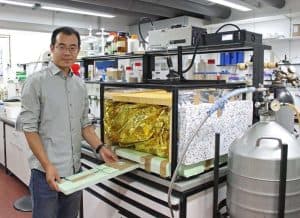
Passive day cooling is a promising technology for the sustainable reduction of energy consumption. It avoids the heating up of buildings by solar radiation and dissipates accumulated heat without external energy consumption. Researchers at the University of Bayreuth have now created a test system with which the materials used for passive cooling can be reliably characterized and compared—regardless of weather conditions and environmental conditions. The measurement setup presented in Cell Reports Physical Science is the first step towards a standardized, globally applicable test system for comparing high-performance cooling materials.
“Increasing fossil energy consumption worldwide is still contributing to global warming and is a major cause of the heating up of our cities. Cooling buildings during the day using passive cooling materials has great potential to establish itself as an effective tool for energy conservation. Many technologically interesting materials and classes of material have consequently been developed for the dissipation of heat, but it is still a challenge to precisely determine and compare their performance. The laboratory set-up we have designed helps to overcome this difficulty. It is a test system that makes important contributions to the characterization of previously existing cooling materials and the design of new ones, regardless of the weather,” says Prof. Dr. Markus Retsch, project leader of the study and Chair of Physical Chemistry I at the University of Bayreuth.
The laboratory-based test system mimics the most important factors that influence passive cooling performance. Essential components are therefore a simulator of sunlight, an aluminum dome cooled with liquid nitrogen that absorbs thermal radiation, a changeable filter that only allows light rays of certain wavelengths to pass through, and a heatable gas flow that can be used to set a specific ambient temperature. This allows the intensity of solar radiation, the temperatures acting on the cooling materials, and other environmental influences to be simulated on a miniature scale.
Outdoors, these factors change quickly and cannot be controlled, but in the new measurement setup from Bayreuth, they can be set with great specificity. As a result, the test results are reproducible at any time, regardless of time, place, or weather. This is the only way to characterize the properties and behavior of cooling materials with high precision and to compare them under identical conditions. The measurement setup is robust, cost-effective, and also has the advantage of being replicable without great technical effort.
The Bayreuth scientists have demonstrated the high performance and reliability of the test system on three different materials: a silver mirror (Ag), a film of polydimethylsiloxane (PDMS) applied to silver, and a graphite-coated silicon wafer. In doing so, they not only tested the heating and cooling of the materials, but also determined their cooling performance.
“Our measurement setup is the first step towards standardized performance comparisons between cooling materials that have been developed around the world under very different climatic and weather conditions. Such a test system is an important prerequisite for passive cooling to become a globally applied technology for significantly reducing energy consumption,” says Dr. Qimeng Song, first author of the study and postdoc at the research group led by Prof. Dr. Markus Retsch.
